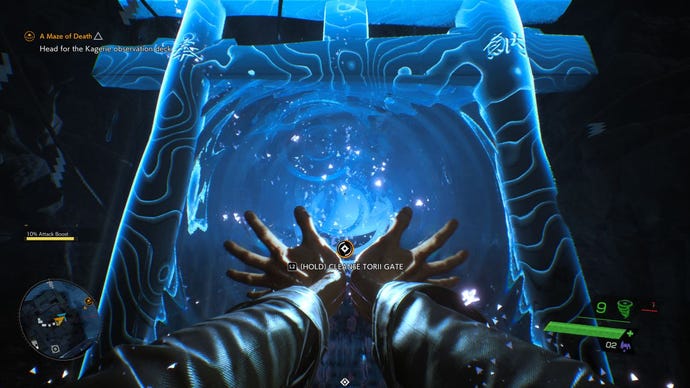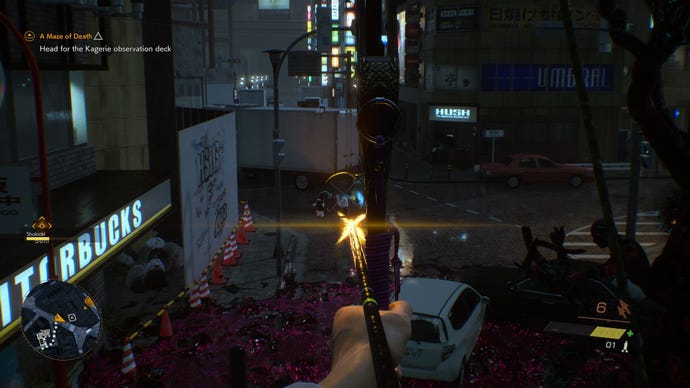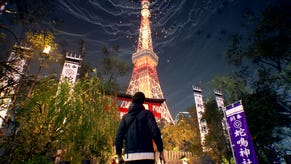Ghostwire: Tokyo would be the perfect holiday, if it weren’t for all the ghosts
Sightseeing meets wight-fleeing
There’s a YouTube channel I’m fond of called Virtual Japan, where a 4K camera serenely glides through gorgeous Japanese hotspots: Sapporo in the snow, Christmas lights in Tokyo, residential back streets in the pouring rain. You hear nothing but ambient city sounds and the tromping of a cameraman's feet. You could be watching a HUD-free FPS, albeit with incredi-graphics. Finally, in Ghostwire: Tokyo, someone has made a game of it, albeit with occasional ghost zapping.
Whatever is said of the game they host in their virtual city, Tango Gamework’s Tokyo is a staggering construction. It’s a condensed version; where you can sprint across the map in under ten minutes and iconic districts bleed into each other without needing to stuff into the metro to take them all in. You wouldn’t get far if you did - like everything else, the trains sit abandoned, festooned with the clothes of punters vanished by the game’s opening spectral blast. Point is: it’s the city redesigned for worn soles (and littered with shorn souls) and dense enough with stuff to gawk at that after six hours I’m still not tempted by fast travel.
Ghostwire has the same eye for detail as Yakuza’s Kamurocho, but applied on a city-wide scale - and it tickles the same parts of the brain. You’re drinking in the shopfronts, the billboards, the flyers plastered in dingy alleys. What’s missing, obviously, is the people, but this isn’t some washed-out post-apocalypse. It’s set in the immediate minutes after the departure, so music still pipes out of stores (zippy pop in convenience stores, smooth jazz from discreet bars) and puzzled dogs are looking for their owners. Is it wrong to think this is an ideal way to take in a city? Nailing a perfectly framed photo is certainly easier without the masses.
Part of its magic, in these early hours at least, is how it carefully doles out the sights. The aforementioned vanishing floods the city with a deadly fog, a contrivance that both creates a more stage-managed path through the landmass and obfuscates the surrounding streets so it can pull off big reveals when the smog lifts. Yes, you can clamber up to the rooftops to get a sense of nearby topography, but there’s something very satisfying in seeing hazy streets burst into neon clarity. It also helps that things kick off at the well trodden (literally) Shibuya Scramble, meaning the map pushes into lesser known, quirkier territory from there.

Alice’s initial impressions pondered how open world the game would be, and the answer is not much… and then a lot. While mist locks you to corridors of action for the opening hour, you soon start finding and cleansing corrupted torii gates which push back the literal fog of war and reveal knotty burrows of back alleys and an equally vast playground on the rooftops above. I’m not as sold on the aerial action; you zip up by grappling to bird demons and then use a hovering ability to explore further. But with no fall damage - for Silly Narrative Reasons - there’s no peril to any of it. It’s a bit too frictionless, as if you’re noclipping to victory.
Also odd is how much of Ghostwire revolves around collecting souls and depositing them in phone booths. (Again, Silly Narrative Reasons.) It’s not just an optional collectathon but your main means of levelling up, and there are clusters of them crammed in every nook. The more I play, the more I’m convinced someone at Tango is a huge Crackdown fan. It has the same rhythm as that game’s orb hunting: every soul cloud you hoover up leaves another prize in your eyeline and so you find yourself pulled from pick-up to pick-up in a hypnotic daze. To give you an idea of how much of this stuff there is, in six hours I’ve collected 30,000 of 240,000 souls.

There’s nothing inherently wrong with the idea, but it’s weirdly low energy from the House of Shinji Mikami, gaming’s foremost rollercoaster architect. A career that stretches between Resident Evil, God Hand and Vanquish tells us not to pigeonhole him, but I’m surprised to see his involvement in something this sedate. On the flipside: it does go hand-in-hand with the virtual tourism. What is the quest if not an excuse to spend tens of hours getting intimate with every cul-de-sac? I just worry that it might prove repetitive in the long run. Ask me again in 210,000 souls’ time, when I file the review.
What makes this especially jarring is that when combat kicks off, it’s as Mikami as hell. Ghostly salarymen and headless school girls swarm the screen as you chip away at their outer body to expose a life core, ready to yank out in a shower of tasty particle effects. This focus on crowd control and prioritising between long- and close-range threats is stuff Mikami’s been doing for decades. What makes it quirkier is the decision to opt for offensive hand gestures instead of guns - no, not flipping the bird, but Kuji-kiri-inspired digit flexes that summon elemental projectiles.

If you were being ungenerous you could say that the wind projectile is a pistol, the water slash is a shotgun and the fire blast is an RPG. But a lot is squeezed from these simple moves. Wide arcs of water eat through huddles of schoolkids, say, or prove deadly if you lead a demonic platoon through a bottleneck. And a charged explosive shot can scatter a crowd, letting you swiftly execute floored enemies with a flick of a paper seal. Given that fights are all about overwhelming you from multiple angles, any trick to whittle down numbers is a godsend.
As far as I can tell, there are no magic attacks beyond these three, so I’m intrigued to see how much can be made of the moves over tens of hours. Right now, I’m content ripping through ghosties and then whipping out my phone to see how the sights compare to Google Street View. There are enough fights to keep me watchful, but not enough to get in the way of my virtual holiday. Can this balance be sustained over the three quarters of map I’ve yet to demist? Should Virtual Japan be worried about Tango eating their lunch? We’ll find out soon enough.
This preview is from playing the PS5 build, as are the screenshots


















